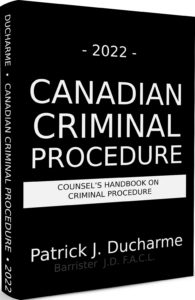 |
| Patrick Ducharme |
Section 52(1) provides that the Constitution Act is the supreme law of Canada, and any law that is inconsistent with the provisions of the Constitution is, to the extent of the inconsistency, of no force or effect. Thus, applications to strike down legislation are made under this section. These applications must comply with Rule 27. Applications must be served on the Constitutional Law Division of the Ministry of the Attorney General of Ontario and the Regional Office of the Attorney General of Canada at Toronto or the office of the Attorney General of Canada at Ottawa and the office of the prosecutor having carriage of the proceedings;
1. Section 24 is the general remedy section for all other Charter applications. A request for the exclusion of evidence is made pursuant to subsection 24(2). To obtain other remedies that might be “appropriate and just” the applications are brought pursuant to subsection 24(1). This would be the subsection to use, for example, if the application is to obtain a stay of proceedings;
2. The applicant bears the legal burden of establishing a breach of a constitutional right on the civil standard of a balance of probabilities;
3. On occasion the legal burden of proof will shift, for example, where the applicant alleges a breach of section 8 and it is established that the search in question was without warrant. Once established, there is a presumption that the search and seizure was unreasonable and the burden shifts to the prosecution to establish the reasonableness of the search;
4. All trial courts have the power to declare law unconstitutional, pursuant to section 52.2
24(1) Charter: Enforcement of guaranteed rights and freedoms — Anyone whose rights or freedoms, as guaranteed by this Charter, have been infringed or denied may apply to a court of competent jurisdiction to obtain such remedy as the court considers appropriate and just in the circumstances.
(2) Exclusion of evidence bringing administration of justice into disrepute — Where, in proceedings under subsection (1), a court concludes that evidence was obtained in a manner that infringed or denied any rights or freedoms guaranteed by this Charter, the evidence shall be excluded if it is established that, having regard to all the circumstances, the admission of it in the proceedings would bring the administration of justice into disrepute.
A court of competent jurisdiction is one that has jurisdiction to grant a Charter remedy. A Justice at a preliminary inquiry is not a court of competent jurisdiction to determine Charter issues or the constitutionality of a statutory provision. A Justice presiding at a bail hearing is also not a court of competent jurisdiction. Even an extradition Judge has only limited Charter powers. The extradition Judge has jurisdiction to stay a proceeding as an abuse of process, and, has power to order disclosure but disclosure can only be ordered as it relates to the relevant issues of an extradition hearing.
To exclude evidence pursuant to section 24 of the Charter the court does not have to find that the evidence itself is causally connected to the Charter infringement. Subsection 24(2) is generally engaged as long as a Charter violation occurs during the course of obtaining the evidence in question. A temporal link is generally sufficient unless it is extremely tenuous. The Court generally looks at the entire chain of events and will find the connection unless it is extremely remote. If the connection between the infringement and the evidence is extremely remote the court may find that the evidence was not “obtained in a manner that infringes a right or freedom under the Charter.”
The cases of Grant4 and Harrison5 in the Supreme Court of Canada in 2009 led to the court focusing on three specific factors to determine when the admission of evidence would bring the administration of justice into disrepute. The factors are:
a. the seriousness of the Charter-infringing state conduct (we do not want the admission of evidence to send the wrong message that the justice system condones its serious state misconduct);
b. the impact of the breach on the Charter-protected interests of the accused (we do not want the abuse of an individual’s right to seem like it counts for very little); and,
c. society’s interest in the adjudication of the case on its merits (we do not want to seem as though less serious or technical failings by the police improperly prevent a trial on the merits).
These two cases suggest that the court is required to balance each of these factors in determining whether, in all the circumstances, the admission of the impugned evidence would bring the administration of justice into disrepute.
In 2014 the Supreme Court of Canada delivered its judgment in R. v. Taylor6. The case involved an accused who was charged with three counts of impaired driving causing bodily harm. He was taken to the hospital and the investigating officer made the mistake of failing to provide the accused with an opportunity to have access to his counsel of choice in a timely fashion, despite the fact that there appeared to be ample opportunity to do so. The court commented that receiving medical treatment in a hospital “is not in a Charter-free zone”.
The denial of access to a lawyer in a reasonable time amounted to a breach of the man’s right to consult counsel pursuant to section 10(b) of the Charter. The court found that while the public does have an interest in an adjudication of cases on the merits, the public also has an interest, “in ensuring that the justice system remains above reproach in its treatment of those charged with these serious offences”7.
Athough Intoxilyzer results are generally considered to be reliable evidence, that evidence has to be excluded in circumstances where to include the evidence might lead to the conclusion that the justice system was not above reproach. This reasoning, the court said, supported its earlier decision in R. v. Spencer.
Other relief can be granted apart from the exclusion of evidence. A trial Judge may:
1. Enter a stay of proceedings;
2. Order disclosure and an adjournment;
3. Permit the defence to call further witnesses or recall witnesses for further examination or cross-examination.
4. Declare a mistrial;
5. Award costs.
s. 52 Constitution Act: The Constitution of Canada is the supreme law of Canada, and any law that is inconsistent with the provisions of the Constitution is, to the extent of the inconsistency, of no force or effect.
Unlike all other Charter challenges, section 52 of the Constitution Act can be used to challenge the constitutional validity of any law, whether or not the person challenging is directly affected by that law. A law is unconstitutional if either its purpose or its impact violates the enunciated rights of the Charter. And, according to subsection 52(1) a finding of unconstitutionality renders the provision of no force or effect to the extent of its inconsistency with the provisions of the Charter.

The above is the an excerpt of Patrick J Ducharme's book, Canadian Criminal Procedure, available at Amazon or in bulk through MedicaLegal Publishing along with Criminal Trial Strategies.
Subscribe to Patrick Ducharme's Youtube Channel
